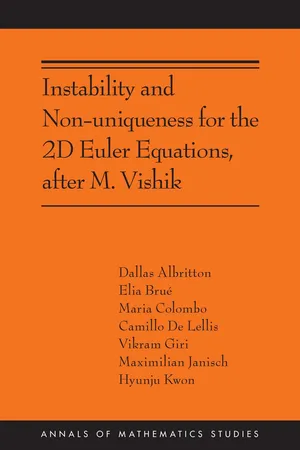
Instability and Non-uniqueness for the 2D Euler Equations, after M. Vishik
- 144 pages
- English
- PDF
- Available on iOS & Android
Instability and Non-uniqueness for the 2D Euler Equations, after M. Vishik
About this book
An essential companion to M. Vishik’s groundbreaking work in fluid mechanics
The incompressible Euler equations are a system of partial differential equations introduced by Leonhard Euler more than 250 years ago to describe the motion of an inviscid incompressible fluid. These equations can be derived from the classical conservations laws of mass and momentum under some very idealized assumptions. While they look simple compared to many other equations of mathematical physics, several fundamental mathematical questions about them are still unanswered. One is under which assumptions it can be rigorously proved that they determine the evolution of the fluid once we know its initial state and the forces acting on it. This book addresses a well-known case of this question in two space dimensions. Following the pioneering ideas of M. Vishik, the authors explain in detail the optimality of a celebrated theorem of V. Yudovich from the 1960s, which states that, in the vorticity formulation, the solution is unique if the initial vorticity and the acting force are bounded. In particular, the authors show that Yudovich’s theorem cannot be generalized to the L^p setting.
Frequently asked questions
- Essential is ideal for learners and professionals who enjoy exploring a wide range of subjects. Access the Essential Library with 800,000+ trusted titles and best-sellers across business, personal growth, and the humanities. Includes unlimited reading time and Standard Read Aloud voice.
- Complete: Perfect for advanced learners and researchers needing full, unrestricted access. Unlock 1.4M+ books across hundreds of subjects, including academic and specialized titles. The Complete Plan also includes advanced features like Premium Read Aloud and Research Assistant.
Please note we cannot support devices running on iOS 13 and Android 7 or earlier. Learn more about using the app.
Information
Table of contents
- Cover
- Contents
- Preface
- Acknowledgments
- Introduction
- Chapter 1. General strategy: Background field and self-similar coordinates
- Chapter 2. Linear theory: Part I
- Chapter 3. Linear theory: Part II
- Chapter 4. Nonlinear theory
- Appendix A
- Appendix B
- Bibliography
- Index